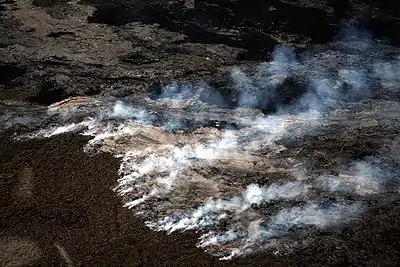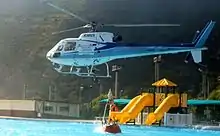Wildfire suppression
Wildfire suppression is a range of firefighting tactics used to suppress wildfires. Firefighting efforts in wild land areas require different techniques, equipment, and training from the more familiar structure fire fighting found in populated areas. Working in conjunction with specially designed aerial firefighting aircraft, these wildfire-trained crews suppress flames, construct fire lines, and extinguish flames and areas of heat to protect resources and natural wilderness. Wildfire suppression also addresses the issues of the wildland–urban interface, where populated areas border with wild land areas.
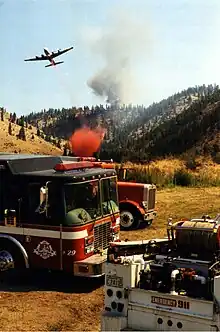
In the United States and other countries, aggressive wildfire suppression aimed at minimizing fire has contributed to accumulation of fuel loads, increasing the risk of large, catastrophic fires.[1][2][3][4][5][6][7][8][9]
History
Australia
Wildland fire, known in Australia as bush fire, has played a major role in Australia due to arid conditions. Notable fire services tasked with wildfire suppression include NPWS (National Parks and Wildlife Service, NSW), the New South Wales Rural Fire Service, the South Australian Country Fire Service, the Western Australian Parks and Wildlife Service, the Victorian Department of Environment, Land, Water and Planning (DELWP), and the Country Fire Authority.[10][11][12]
Canada
Canada contains approximately 3,964,000 km2 (1,531,000 sq mi) of forest land.[13] Seventy-five percent of this is boreal forest, made up primarily of coniferous trees. More than 90 percent of Canadian forest land is publicly owned, and the provincial and territorial governments are responsible for fire-suppression activities. The Federal Canadian Interagency Forest Fire Centre (CIFFC) provides operational fire-control services and links to all provincial and territorial fire agencies.
During a typical year there are over 9,000 forest fires in Canada, burning an average of 2.5 million hectares (ha) or 9,700 square miles (25,000 km2). The number of fires and area burned can vary dramatically from year to year. Average suppression costs are $500 million to $1 billion annually.
In Canada, two-thirds of all forest fires are caused by people, while lightning causes the remaining third. Despite this, lightning fires account for over 85 percent of the area burned in Canada, largely because many of the lightning-caused fires occur in remote, inaccessible areas. Currently about ninety percent of forest fires are fought. Generally fires near communities, industrial infrastructure, and forests with high commercial and recreation value are given high priority for suppression efforts. In remote areas and wilderness parks, fires may be left to burn as part of the natural ecological cycle.[14]
United States
Indigenous communities embraced fire as an ally in preserving nature, but once populations began to grow across the U.S., wildfires started to trigger unprecedented destruction of property and sometimes resulted in massive death tolls. Greater impact on people's lives led to government intervention and changes to how wildfires were addressed.
One of the first turning points for firefighting philosophies in the U.S. happened in October 1871, the year of the Great Chicago Fire. Six years removed from the Civil War, the Fire destroyed more than 17,000 buildings across the Windy City, upended thousands of lives and devastated their thriving business community, which did not fully recover until the World's Fair came to Chicago in 1893.[15] The Great Chicago Fire left an indelible mark on the city, and much of its lasting impact came from the introduction of more sensible building codes.
The same day as the Chicago Fire, a much larger, more deadly, but less-discussed fire occurred, which had a more significant influence on the federal government and its role in fire management.
The Peshtigo Fire broke out on the morning of October 8, 1871. It burned for three days, and while estimates vary, the consensus is that it killed more than 1,200 people – making it the deadliest wildfire in American history to this day.[16] In addition to the number of people killed, the fire burned more than 1.2 million acres of land and spread to nearby towns, where it caused even more damage. The entire town of Peshtigo was destroyed within an hour of the start of the fire.[16]
News of the historical destruction spread slowly. People soon learned of the Peshtigo Fire in addition to the Great Chicago Fire, as well as another fire in Michigan which occurred at the same time that had burned more than two million acres.
As a result of the 1871 fire breakouts, the federal government saw that it needed to act. This led in 1876 to the creation of the Office of Special Agent in the U.S. Department of Agriculture to assess the quality and conditions of forests in the United States.[17] As the forerunner of the U.S. Forest Service, this was the first time that wildfire management was placed under government purview.
Objectives and risks
Safety
Protection of human life is first priority for firefighters. Since 1995, when arriving on a scene, a fire crew will establish safety zones and escape routes, verify communication is in place, and designate lookouts (known in the U.S. by the acronym LCES, for lookouts, communications, escape routes, safety zones). This allows the firefighters to engage a fire with options for a retreat should their current situation become unsafe. Although other safety zones should be designated, areas already burned generally provide a safe refuge from fire provided they have cooled sufficiently, are accessible, and have burned enough fuels so as to not reignite. Briefings may be done to inform new fire resources of hazards and other pertinent information.[18]
A great emphasis is placed on safety and preventing entrapment, a situation where escape from the fire is impossible. Prevention of this situation is reinforced with two training protocols, Ten Standard Firefighting Orders and Eighteen Situations That Shout Watch Out,[19] which warn firefighters of potentially dangerous situations, developed in the aftermath of the Mann Gulch fire. As a last resort, many wildland firefighters carry a fire shelter. In this inescapable situation, the shelter will provide limited protection from radiant and convective heat, as well as superheated air. Entrapment within a fire shelter is called a burnover. In Australia, firefighters rarely carry fireshelters (commonly referred to as "Shake 'N' Bake" shelters); rather, training is given to locate natural shelters or use hand tools to create protection; or, in the instance of 'burnover' in a tanker or other fire appliance, 'fire overrun' training is used.[20]
Hazards beyond the fire are posed as well. A very small sample of these include: unstable/hazardous trees, animals, electrical cables, unexploded ordnance, hazardous materials, rolling and falling debris, and lightning.[18]
Personal safety is also vital to wildland firefighting. The proper use of PPE (personal protective equipment) and firefighting equipment will help minimise accidents. At the very minimum, wildland firefighters should have proper fire-retardant clothing (such as Nomex), protective headgear, wildland firefighting-specific boots, gloves, water for hydration, fire shelters, eye protection, and some form of communication (most commonly a radio).
Resource protection
Other resources are ranked according to importance and/or value. These include but are not limited to human health and safety, construction cost, ecological impacts, social and legal consequences and the costs of protection. Defendability is also considered, as more effort will need to be expended on saving a house with a wooden-shake roof than one with a tile roof, for example.[21][22]
Ecosystem changes
While wildfire suppression serves human safety and resource protection, the lack of natural fires can be the cause of ecosystem changes, as can the size of fires when they do occur. Fire ecology is accordingly not as simple as many might assume. Across the global grassland and savanna ecosystems, fire suppression is frequently found to be a driver of woody encroachment.
Organization
Across the United States, wildfire suppression is administered by land management agencies including the U.S. Forest Service, Bureau of Land Management, U.S. Fish and Wildlife Service, National Park Service, the Bureau of Reclamation, the Army Corps of Engineers, and state departments of forestry. All of these groups contribute to the National Wildfire Coordinating Group and the National Interagency Fire Center.
The National Interagency Fire Center hosts the National Interagency Coordination Center (NICC). NICC's primary responsibility is positioning and managing national resources (i.e. Hotshot Crews, smokejumpers, air tankers, incident management teams, National Caterers, mobile shower units, and command repeaters). NICC also serves as clearing house for the dispatch ordering system. Reporting to NICC are 10 Geographic Area Coordination Centers (Alaska, Great Basin, Northern Rockies, Rocky Mountains, Southern California, Northern California, Eastern, Southern, Southwest and Northwest).[23] Under each GACC are several dispatch zones.
Management
Managing any number of resources over varying-size areas in often very rugged terrain is extremely challenging. An incident commander (IC) is charged with overall command of an incident. In the U.S., the Incident Command System designates this as being the first on scene providing they have sufficient training. The size of the fire, measured in acres or chains, as well as the complexity of the incident and threats to developed areas, will later dictate the class-level of IC required. Incident management teams aid on larger fire incidents to meet more complex priorities and objectives of the incident commander. It provides support staff to handle duties such as communication, fire behavior modeling, and map- and photo-interpretation. Again in the U.S., management coordination between fires is primarily done by the National Interagency Fire Center (NIFC).[24]
| A | B | C | D | E | F | G |
| 0–1/4 acre | 1/4–10 acres | 10–99 acres | 100–299 acres | 300–999 acres | 1000–4999 acres | 5000+ |
Specific agencies and different incident management teams may include a number of different individuals with various responsibilities and varying titles. A fire information officer (PIOF) generally provides fire-related information to the public, for example. Branch chiefs and division chiefs serve as management on branches and divisions, respectively, as the need for these divisions arise. Investigators may be called to ascertain the fire's cause. Prevention officers such as forest rangers may patrol their jurisdictional areas to teach fire prevention and prevent some human-caused fires from happening to begin with.[18]
Communication
Information may be communicated on fires in many forms. Radios, vocals, visual signals such as flagging and mirrors, literature such as an IAP or incident action plan, whistles and mobile touch-screen computer terminals are some examples.[25] The USFS Visual Signal Code system provides symbols used to communicate from ground to air, while aircraft may use wing tilting, motor gunning or circling to communicate air-to-ground.[18]
Radio communication is very typical for communication during a wildfire. This is due to the wide coverage provided and the ability to communicate in a one-to-many format. One of the most popular radio manufacturers for this application is Relm Wireless (also known as Bendix King and BK Radio). The company is based in Florida, U.S., and holds many contracts with various government entities.[26] The other up-and-coming company entering this niche market is Midland Radio. Its U.S. headquarters is in the midwest (Kansas City, Missouri), and it manufacturers many radio models, including mobiles and portables.[27]
Tactics

Operating in the U.S. within the context of fire use, firefighters may only suppress fire that has become uncontrollable. Conversely, fires or portions of a fire that have previously been engaged by firefighters may be treated as fire use situation and be left to burn.
All fire suppression activities are based from an anchor point (such as lake, rock slide, road or other natural or artificial fire break). From an anchor point firefighters can work to contain a wild land fire without the fire outflanking them.
Large fires often become extended campaigns. Incident command posts (ICPs) and other temporary fire camps are constructed to provide food, showers, and rest to fire crews.
Weather conditions and fuel conditions are large factors in the decisions made on a fire. Within the U.S., the Energy Release Component (ERC) is a scale relating fuel energy potential to area. The Burning Index (BI) relates flame length to fire spread speed and temperature. The Haines Index (HI) tracks stability and humidity of air over a fire. The Keetch–Byram dought index relates fuels to how quickly they could ignite and to what percentage they should burn. The Lightning Activity Level (LAL) ranks lightning potential into six classes.[18]
Fuel models are specific fuel designations determined by energy burning potential. Placed into 13 classes, they range from "short grass" (model 1) to "logging slash" (model 13). Low-numbered models burn at lower intensities than those at the higher end.
Direct attack
Direct attack is any treatment applied directly to burning fuel such as wetting, smothering, or chemically quenching the fire, or by physically separating the burning from not burned fuel. This includes the work of urban and wildland fire engines, fire personnel and aircraft applying water or fire retardant directly to the burning fuel. For most agencies, the objective is to make a fireline around all fire meant to be suppressed.
Indirect attack
Preparatory suppression tactics used a distance away from the oncoming fire are considered indirect. Firelines may be built in this manner as well. Fuel reduction, indirect firelines, contingency firelines, backburning and wetting unburnt fuels are examples. This method may allow for more effective planning. It may allow for more ideally placed firelines in lighter fuels using natural barriers to fire and for safer firefighter working conditions in less smoke filled and cooler areas. However, it may also allow for more burned acreage, larger hotter fires, and the possibility of wasted time constructing unused firelines.[18]
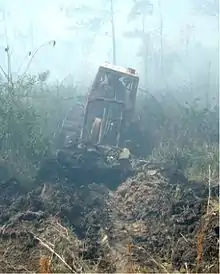
Attempts to control wildfires may also include by controlling the area that it can spread to by creating control lines: boundaries that contain no combustible material. These may be constructed by physically removing combustible material with tools and equipment, or portions may be naturally occurring. Lines may also be created by backfiring: creating small, low-intensity fires using driptorches or flares. The resultant fires are extinguished by firefighters or, ideally, directed in such a way that they meet the main fire front, at which point both fires run out of flammable material and are thus extinguished. Additionally, the use of long-term fire retardants, fire-fighting foams, and superabsorbent polymer gels may be used. Such compounds reduce the flammability of materials by either blocking the fire physically or by initiating a chemical reaction that stops the fire.
However, any method can fail in the face of erratic or high-intensity winds and changing weather. Changing winds may cause fires to change direction and miss control lines. High-intensity winds may cause jumping or spotting as burning embers are carried through the air over a fireline. Burning trees may fall and burning materials may roll across the line, effectively negating the barrier.
Mop-up
The threat of wildfires does not cease after the flames have passed, as smoldering heavy fuels may continue to burn unnoticed for days after flaming.[28] It is during this phase that either the burn area exterior or the complete burn area of a fire is cooled so as to not reignite another fire.
Rehabilitation
Constructed firelines, breaks, safety zones and other items may damage soil systems, encouraging erosion from surface run-off and gully formation. The loss of plant life from the fire also contributes to erosion. Construction of waterbars, the addition of plants and debris to exposed soils and other measures help to reduce this.[29]
Fires at the wildland–urban interface
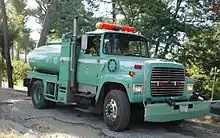
Wildfires can pose risks to human settlement in three main scenarios. The first can happen at the classic wildland–urban interface, where urban or suburban development borders wild land. The second happens at the mixed wildland–urban interface, where homes or small communities are interspersed throughout a wild area, and the boundary between developed and non-developed land is undefined. The third occurs in the occluded wildland–urban interface, where pockets of wild land are enclosed within cities.[30]
Expansive urbanization and other human activity in areas adjacent to wildlands is a primary reason for the catastrophic structural losses experienced in wildfires.[31] Continued development of wildland–urban interface firefighting measures and the rebuilding of structures destroyed by fires has been met with criticism.[20] Communities such as Sydney and Melbourne in Australia have been built within highly flammable forest fuels. The city of Cape Town, South Africa, lies on the fringe of the Table Mountain National Park. In the western United States from the 1990s to 2007, over 8.5 million new homes were constructed on the wildland–urban interface.[32]
Fuel buildup can result in costly, devastating fires as more new houses and ranches are built adjacent to wilderness areas. However, the population growth in these fringe areas discourages the use of current fuel management techniques. Smoke from fires is an irritant and a pollutant. Attempts to thin out the fuel load may be met with opposition due to the desirability of forested areas. Wildland goals may be further resisted because of endangered species protections and habitat preservation.[32] The ecological benefit of fire is often overridden by the economic benefits of protecting structures and lives.[33] Additionally, federal policies that cover wildland areas usually differ from local and state policies that govern urban lands.[21][34]
In North America, the belief that fire suppression has substantially reduced the average annual area burned is widely held by resource managers,[35] and is often thought to be self-evident. However, this belief has been the focus of vocal debate in the scientific literature.
Equipment and personnel
Wildfire suppression requires specialist personnel and equipment. Notable examples include smokejumpers (firefighters who parachute into remote areas) and helicopter support.
Efficacy
The success of wildfire suppression techniques is debated amongst the scientific community. A number of studies (produced during the 1990s) using Ontario government fire records compared either the number of fires or the average fire size between areas with and without aggressive fire suppression policies.[36][37] They found that the average fire size was generally smaller in areas of aggressive policy. One report, written in 1998 by Stocks and Weber, said; "Use of fire as a management tool recognizes the natural role of fire and is applied judiciously for ecosystem maintenance and restoration in selected areas."[38] A later 2005 study concluded that "Fire suppression is (functionally) effective insofar as it reduces area burned".[39]
Other studies have concluded that the 20th century change in the fire cycle is a result of climate change.[40] A 1993 study by Bergeron & Archambault said: "post-'Little Ice Age' climate change has profoundly decreased the frequency of fires in the northwestern Québec boreal forest".[41] Critics have also pointed out that small fires are virtually unreported in areas without aggressive fire suppression policies, where detection often relies on reports from settlements or commercial aircraft, leading to incorrect average fire size data for those regions.[42]
See also
References
- Busenberg, George (2004). "Wildfire Management in the United States: The Evolution of a Policy Failure". Review of Policy Research. 21 (2): 145–156. doi:10.1111/j.1541-1338.2004.00066.x.
- Parisien, Marc-André; Barber, Quinn E.; Hirsch, Kelvin G.; Stockdale, Christopher A.; Erni, Sandy; Wang, Xianli; Arseneault, Dominique; Parks, Sean A. (2020). "Fire deficit increases wildfire risk for many communities in the Canadian boreal forest". Nature Communications. 11 (1): 2121. Bibcode:2020NatCo..11.2121P. doi:10.1038/s41467-020-15961-y. ISSN 2041-1723. PMC 7195457. PMID 32358496.
- Marlon, J. R.; Bartlein, P. J.; Gavin, D. G.; Long, C. J.; Anderson, R. S.; Briles, C. E.; Brown, K. J.; Colombaroli, D.; Hallett, D. J.; Power, M. J.; Scharf, E. A.; Walsh, M. K. (2012). "Long-term perspective on wildfires in the western USA". Proceedings of the National Academy of Sciences. 109 (9): E535–E543. doi:10.1073/pnas.1112839109. PMC 3295264. PMID 22334650.
- Parks, Sean A.; Miller, Carol; Parisien, Marc-André; Holsinger, Lisa M.; Dobrowski, Solomon Z.; Abatzoglou, John (2015). "Wildland fire deficit and surplus in the western United States, 1984–2012". Ecosphere. 6 (12): art275. doi:10.1890/ES15-00294.1.
- Kolden, Crystal A. (2019). "We're Not Doing Enough Prescribed Fire in the Western United States to Mitigate Wildfire Risk". Fire. 2 (2): 30. doi:10.3390/fire2020030.
- Ingalsbee, Timothy (2015). "Ecological fire use for ecological fire management: Managing large wildfires by design". In: Keane, Robert E.; Jolly, Matt; Parsons, Russell; Riley, Karin. Proceedings of the Large Wildland Fires Conference; May 19–23, 2014; Missoula, MT. Proc. RMRS-P-73. Fort Collins, CO: U.S. Department of Agriculture, Forest Service, Rocky Mountain Research Station. P. 120-127. 73: 120–127.
- Haugo, Ryan D.; Kellogg, Bryce S.; Cansler, C. Alina; Kolden, Crystal A.; Kemp, Kerry B.; Robertson, James C.; Metlen, Kerry L.; Vaillant, Nicole M.; Restaino, Christina M. (2019). "The missing fire: quantifying human exclusion of wildfire in Pacific Northwest forests, USA". Ecosphere. 10 (4): e02702. doi:10.1002/ecs2.2702.
- Schultz, Courtney A.; Thompson, Matthew P.; McCaffrey, Sarah M. (2019). "Forest Service fire management and the elusiveness of change". Fire Ecology. 15 (1): 13–. doi:10.1186/s42408-019-0028-x.
- Pyne, S. J. (1996). "Wild Hearth A Prolegomenon to the Cultural Fire History of Northern Eurasia". Fire in Ecosystems of Boreal Eurasia. Springer Netherlands. pp. 21–44. ISBN 978-94-015-8737-2.
- "New South Wales Rural Fire Service, Operations". NSW Rural Fire Service. NSW Government. Retrieved 15 February 2014.
- "Country Fire Authority, Op". Country Fire Authority. CFA (Australia). Retrieved 15 February 2014.
- "South Australian Country Fire Service". South Australian Country Fire Service. SACFS. Retrieved 15 February 2014.
- "Natural Resources Canada Statistical Data". Natural Resources Canada. Retrieved 16 August 2019.
- Forest Fire in Canada, Natural Resources Canada, 2008-06-05, archived from the original on 2009-05-30, retrieved 2009-05-01
- "Great Chicago Fire begins". HISTORY. Retrieved 2021-12-30.
- US Department of Commerce, NOAA. "The Great Midwest Wildfires of 1871". www.weather.gov. Retrieved 2021-12-30.
- "Our History". US Forest Service. 2015-10-02. Retrieved 2021-12-30.
- Incident Operations Standards Working Team (January 2006), Incident Response Pocket Guide (PDF), National Wildfire Coordinating Group (NWCG), pp. i–101
- "Standard Firefighting Orders and 18 Watchout Situations". Risk Management. US Forest Service. 29 September 2015. Retrieved 12 October 2015.
- Our Trial by Fire, onearth.org, December 1, 2007, archived from the original on June 30, 2008, retrieved January 7, 2009
- Interagency Strategy for the Implementation of Federal Wildland Fire Management Policy (PDF), National Interagency Fire Council, June 20, 2003, archived from the original (PDF) on September 16, 2008, retrieved 2008-12-21
- Wildland Fire Policy, US Forest Service, retrieved 2008-12-21
- "Interagency Hotshot Crews (IHC)". US Forest Service. 2016-12-21. Retrieved 2021-07-15.
- "An Integration of Remote Sensing, GIS, and Information Distribution for Wildfire Detection and Management" (PDF), Photogrammetric Engineering and Remote Sensing, 64 (10): 977–985, October 1998, archived from the original (PDF) on 2009-08-16
- Hoose, Michael, Tech Tactics, Wildfire Magazine, archived from the original on 2011-07-18, retrieved 2009-01-21
- "RELM Wireless Corporation". www.relm.com. Archived from the original on 27 July 2012. Retrieved 13 January 2022.
- "Midland Radio - Midland Radio | Communication Solutions for Your World". midlandradio.com. Archived from the original on 2 May 2012. Retrieved 13 January 2022.
- de Sousa Costa and Sandberg, 227.
- Effects of Fire on Soils and Erosion: Erosion and Mass Soil Movement, eWater CRC's Bushfire and Catchments, archived from the original on 2007-08-30, retrieved 2009-01-08
- City of West Covina Natural Hazard Mitigation Plan: Section 9 Wildfire, City of West Covina (California, USA), archived from the original on 2008-10-22, retrieved 2009-07-14
- Wildfire Suppression: Strategies for Containing Costs (PDF), National Academy of Public Administration, September 2002, ISBN 978-1-57744-094-9, archived from the original (PDF) on 2007-10-31, retrieved 2009-01-21
- Are Big Fires Inevitable? A Report on the National Bushfire Forum (PDF), Parliament House, Canberra: Bushfire CRC, 27 February 2007, archived from the original (PDF) on 26 February 2009, retrieved 2009-01-09
- Extreme Events: Wild & Forest Fire, archived from the original on 2009-01-14, retrieved 2009-01-07
- van Wagtendonk, Jan W. (2007), "The History and Evolution of Wildland Fire Use", Fire Ecology, 3 (2): 3–17, doi:10.4996/fireecology.0302003, S2CID 85841606 (U.S. Government public domain material published in Association journal. See WERC Highlights -- April 2008)
- Healy, Megan (March 12, 2019). "Cal Poly researchers ready to tackle California's catastrophic fires with new institute". KSBY. Retrieved 12 March 2019.
- Stocks, Brian J (1991), The extent and impact of forest fires in northern circumpolar countries, MIT Press, archived from the original on 2012-04-04, retrieved 2010-08-05
- Ward, P.C.; A.G. Tithecott (1993), "The impact of fire management on the boreal landscape of Ontario", Aviation, Flood and Fire Management Branch Publication, 305.
- Weber, MG; Stocks, BJ (Nov 1998), "Forest Fires and Sustainability in the Boreal Forests of Canada", Ambio, 27 (7): 545–550, archived from the original on 4 April 2012, retrieved 8 July 2010.
- Cumming, S.G. (2005), "Effective fire suppression in boreal forests", Canadian Journal of Forest Research, 35 (4): 772–786, doi:10.1139/x04-174
- Johnson, Edward A (1996), Fire and Vegetation Dynamics: Studies from the North American Boreal Forest, Cambridge University Press, p. 144, ISBN 978-0-521-34943-7
- Yves Bergeron; Sylvain Archambault (1993). "Decreasing frequency of forest fires in the southern boreal zone of Québec and its relation to global warming since the end of the 'Little Ice Age'". The Holocene. 3 (3): 255–259. Bibcode:1993Holoc...3..255B. doi:10.1177/095968369300300307. S2CID 140187485.
- Miyanishi, K; E. A. Johnson (2001), "Comment—A re-examination of the effects of fire suppression in the boreal forest", Canadian Journal of Forest Research, 31 (8): 1462, doi:10.1139/x01-073.{
Further reading
- Arno, S. F.; R. P. hammerly (1984), Timberline. Mountain and Arctic Forest Frontiers, Mountaineers Books, p. 304, ISBN 978-0-89886-085-6, ASIN 0898860857
- Arno, S.F.; Worrall, J; Carlson, C.E. (1995), "Larix lyallii: Colonist of tree-line and talus sites", Ecology and Management of Larix Forests: A Look Ahead: 72–78.
- Besenyo, Janos: Forest Fires as the New Form of Terrorism, Terrorism and Political Violence, pages 1–13, Published online: 11 Jul 2017
- Casals P, Valor T, Besalú A, Molina-Terrén D. Understory fuel load and structure eight to nine years after prescribed burning in Mediterranean pine forests. DOI: 10.1016/j.foreco.2015.11.050
- de Souza Costa, Fernando; Sandberg, David (2004), "Mathematical model of a smoldering log" (PDF), Combustion and Flame, 139 (3): 227–238, doi:10.1016/j.combustflame.2004.07.009, S2CID 10499171, retrieved 2009-02-06
- Graham, Russell; McCaffrey, Sarah; Jain, Theresa B. (April 2004), "Science Basis for Changing Forest Structure to Modify Wildfire Behavior and Severity" (2.79MB PDF), Gen. Tech. Rep. RMRS-GTR-120, Fort Collins, CO: U.S. Department of Agriculture, Forest Service, Rocky Mountain Research Station, retrieved 2009-02-06
- Karki, Sameer (2002), Community Involvement in and Management of Forest Fires in South East Asia (PDF), Project FireFight South East Asia, archived from the original (PDF) on 2007-07-30, retrieved 2009-02-13
- Mitchell, Joseph W. (September 2006), "Wind-enabled ember dousing", Fire Safety Journal, 41 (6): 444–458, doi:10.1016/j.firesaf.2006.04.002
- Sayre, A. P. (1994), Taiga, Twenty-First Century Books, ISBN 978-0-80-502830-0
- Stocks, B. J.; R. B. Street (1983), "Forest fire weather and wildfire occurrence in the boreal forest of northwestern Ontario", Resources and Dynamics of the Boreal Zone.: 249–265.
- Valor T, González-Olabarria JR, Piqué M. Assessing the impact of prescribed burning on the growth of European pines. DOI: 10.1016/j.foreco.2015.02.002.
External links
- The International Association of Wildland Fire
- Canadian Wildland Fire Information System
- The Canadian Interagency Forest Fire Centre (CIFFC)
- British Columbia Ministry of Forests Protection Branch
- United States National Interagency Fire Center
- Wildfire History and Ecology
- National Institute for Occupational Safety and Health - Fighting Wildfires
- Proposed Wildfire Suppression Technology
